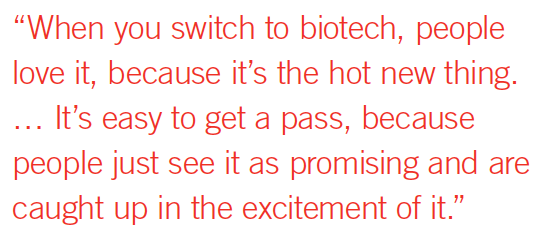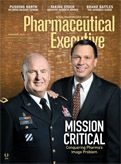The Innovation Distinction: Biopharma's Reputational Pass
Pharmaceutical Executive
The biotech sector has managed to elude the negative perceptions saddling traditional pharma these days. We examine the reasons why.
Fair or not, biotech has managed to elude perception crosshairs
While traditional pharmaceutical companies are taking a reputational hit, biotech organizations, for the most part, are getting a public-perception pass-for now.
Whether or not it’s fair, or accurate, in general, the public views biotech companies as cutting edge, holding the cure to some of the world’s most debilitating diseases, and as alternatives to the traditional pharma enterprise, and its characterization by some as greedy, outdated, and only caring about making money.
Biotechs are surrounded by innovation; they make science fiction-a digital pill, 3D printing, wearable technology-a reality; are located in trendy tech hubs like San Francisco, San Diego, and Boston; and most importantly, they offer hope.
This public perception may not be 100% accurate, but neither is the stereotype that all “traditional” pharma companies live in the stone age, hike up drug prices to make an insane profit, and hold the cure for cancer, but don’t want to share it with the public.
The driving reputational force
So, where does this public perception come from? Experts who spoke with Pharm Exec believe there are several factors, but the most prevalent is a common theme that comes up almost daily when discussing the pharma industry-drug pricing.
“When you talk about the reputation of the industry, the one thing that comes to mind for me immediately is a lot of the rhetoric around pricing, and [the belief] that there is a [price] gouging of consumers by biopharma companies on products that have been placed on the market in the past couple of years,” says Ralph Marcello, Deloitte’s national biopharmaceutical leader.
Marcello contends that while there are a few “bad actors” who have given the pharma industry a bad reputation, in general, it is not the norm. Of course, that is not the narrative that typically gets told in the media.
This leads to another fundamental difference between many of the biotech startups and traditional pharma companies that experts say is contributing to the reputational differences-commercialization. In most cases, by the time the work coming out of a biotech is ready to be brought to market, those assets have already been acquired by a larger company, who sets the price and everything else around them. That company, not the biotech developer, is the one who gets the public attention, and in recent years, the backlash, that comes with the innovation.
“The delineation comes between companies whose products are on the market versus biotech companies that are in early stages of discovery and development, and are not commercialized,” says Marcello. “Once those become products in the market and they commercialize those products, it is the price of the product that causes a lot of heartburn for various people across the industry.”
Bursting the happy bubble
Will the golden-child status the biotech industry is currently enjoying ever slip to the levels traditional pharma is experiencing today? It’s possible, but it would take a while. Elizabeth Iorns, the founder of Science Exchange, a marketplace for outsourced research, works with biotech and pharma companies. She also works with the general public and sees first-hand how reputation between the two segments differ.
“In some ways, they are sheltered from the criticism of pharma, because they don’t have commercialized products,” she says. “But, that piece will become more challenging for them as they begin to commercialize themselves. I think Gilead [Sciences] is an example of that.”
Gilead, the biotech giant, took heavy criticism in the press for its pricing of hepatitis C drug Sovaldi. However, as Investor’s Business Daily pointed out, the therapy didn’t just treat a disease, but, in most cases, cured patients after about three months. Sovaldi’s follow-on drug, Harvoni, also has a high cure rate.
The reason it may take a while for the public to criticize biotechs the way they do pharma is very simple, some say-biotechs are better storytellers. They are nimble enough to fight back when lashed out against and have a compelling story to rest on. For example, Gilead. “They have a really amazing therapy that is helping save the lives of people who might have died,” says Iorn. “That’s a really compelling storytelling piece.”
An inside perspective
Unfortunately, it doesn’t matter that pharma companies may also be conducting comparable-type research and coming up with those same life-saving treatments. The public’s perception already starts out biased against them. When it comes to the topic of biotech versus pharma reputation, Dr. Devyn Smith has a unique perspective, having viewed the comparisons from both sides. Smith is currently the chief strategy officer and head of operations for Sigilon Therapeutics, a Cambridge, Mass.-based startup whose mission is to develop improved treatments for chronic disease using implanted cells shielded by proprietary biomaterials from immune attack and the foreign body response. But, before joining Sigilon, Smith was part of Pfizer’s Medicinal Sciences Division of R&D, where he was head of business operations and strategy.
Pharma companies are an easy target for the public, because people see their copays or out-of-pocket expenses more when it comes to their prescriptions, Smith explained. For example, a patient may go to a hospital and

have a $30,000 bill, but they only see $150 of it coming out of their pocket.
Smith said he would experience criticism for working in pharma from friends and family.
“You would get a lot of flak at times and hear things like, ‘you guys are overcharging’ and ‘they’re just in it for the money,’” he said. “When you switch to biotech, people love it, because it’s the hot new thing. It’s interesting and cutting edge. It’s easy to get a pass, because people just see it as promising and are caught up in the excitement of it.”
Smith has an additional layer of unique perspective. For a portion of the time he worked in traditional pharma, he lived in the UK.
“They had a very positive view of pharma,” he says of the UK. “If you said you worked at a pharma company, they would say things like, ‘oh yeah, you guys do really good things.’ Coming back to the states you would tell a cab driver or someone you know that you work at a pharma company and you would never know the reaction you would get. Sometimes it was positive, sometimes they would look at you and make negative comments.”
Bridging the gap
In the eyes of the general public, it’s clear that biotech companies have an advantage when it comes to reputation. They are viewed as a sign of future hope and the public has high expectations for them.
Will this reputation high last? That’s a question that experts are not sure about, especially as more biotech companies decide to bring their products to market on their own, and have to deal with issues like pricing.
One thing is certain: whether right or wrong, the public currently has a sweet spot for biotechs over traditional pharma companies.
Michelle Maskaly is Pharm Exec’s Senior Editor. She can be reached at michelle.maskaly@ubm.com and on Twitter at @mmaskaly

Addressing Disparities in Psoriasis Trials: Takeda's Strategies for Inclusivity in Clinical Research
April 14th 2025LaShell Robinson, Head of Global Feasibility and Trial Equity at Takeda, speaks about the company's strategies to engage patients in underrepresented populations in its phase III psoriasis trials.
Key Findings of the NIAGARA and HIMALAYA Trials
November 8th 2024In this episode of the Pharmaceutical Executive podcast, Shubh Goel, head of immuno-oncology, gastrointestinal tumors, US oncology business unit, AstraZeneca, discusses the findings of the NIAGARA trial in bladder cancer and the significance of the five-year overall survival data from the HIMALAYA trial, particularly the long-term efficacy of the STRIDE regimen for unresectable liver cancer.
Expanding Immune Response Testing to Support Vaccine Development
April 22nd 2025Nigel McCracken, chief operating officer, Virax Biolabs, discusses the expansion of its ViraxImmune platform into areas such as transplant monitoring, vaccine efficacy, latent virus reactivation, and CAR T cell therapy.